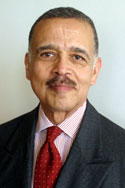ARCHIVES
OF EDITORIALS
May 26, 2005
An
end to bipartisan politics
During the recent presidential election, blacks
were constantly reminded to get out the vote. The concern was
that the president will probably be able to appoint two or three
new members to the U.S. Supreme Court. Such a shift in a nine-member
court creates the opportunity to change the law in several critical
areas.
Conservatives have made it clear that they want to change the
judicial system. Tom DeLay, a Republican congressman from Texas,
has openly attacked the relationship between the federal courts
and the Legislature. He led an effort for Congress to intervene
in the Terry Schiavo case to prevent the Florida state court from
permitting the death of a woman who had been in a coma for decades.
The judges in federal courts are chosen by the president with
the “advice and consent” of the Senate. Appointment
to a judgeship is usually given extraordinary scrutiny by the
Senate because these appointments are for life, unlike high-level
jobs in the administration which do not survive beyond the next
presidential election.
The Senate is reluctant to deprive a president of his choices
to run the administration. However, senators take another view
of lifetime judicial appointments. Regardless of party affiliation,
senators tend not to support judicial candidates whose views are
too extreme. The courts are expected to be a stabilizing force
between the Congress and the executive branch of government.
The Senate has a rule to prevent the tyranny of the majority.
According to the Constitution, a judge can be appointed by a majority
vote of 51. However, the filibuster rule will enable a minority
to continue to debate an issue until debate is terminated by 60
or more senators. A radical candidate for judge would need 60
supporters even to have his name appear before the Senate for
approval.
Although President Bush has asserted that he has no candidates
in mind for the U.S. Supreme Court, that is most unlikely. Judging
from some of the candidates he has proposed for the Court of Appeals,
it is reasonable to conclude that his choices for the highest
court would be similarly contentious. So Bush has a political
strategy now of getting rid of the Senate filibuster for judicial
appointees.
As with other political strategies, Bush apparently has no compulsion
to adhere to the truth. The first step is to make the public believe
that his appointments are being treated unfairly. The fact is
that 208 of Bush’s 218 appointments have been confirmed.
This confirmation rate is higher than Clinton’s. During
Clinton’s second term the Republicans tried to keep as many
seats as possible unfilled so that a Republican successor could
appoint as many conservatives as possible.
Moderates in the Republican Party contested President Nixon’s
appointment of archconservatives to the U.S. Supreme Court. Harold
Carlswell of Florida and Clement Haynesworth of South Carolina
never survived the approval process. Bush wants to soften up the
process with the fight being waged over candidates for the lower
courts. If that goes well, then potential Supreme Court justices
with extreme views would have an easier time.
The three oldest members of the U.S. Supreme Court are 85, 81
and 75. The battle for a new Supreme Court justice will be upon
us sooner than we think.
Home
Page

